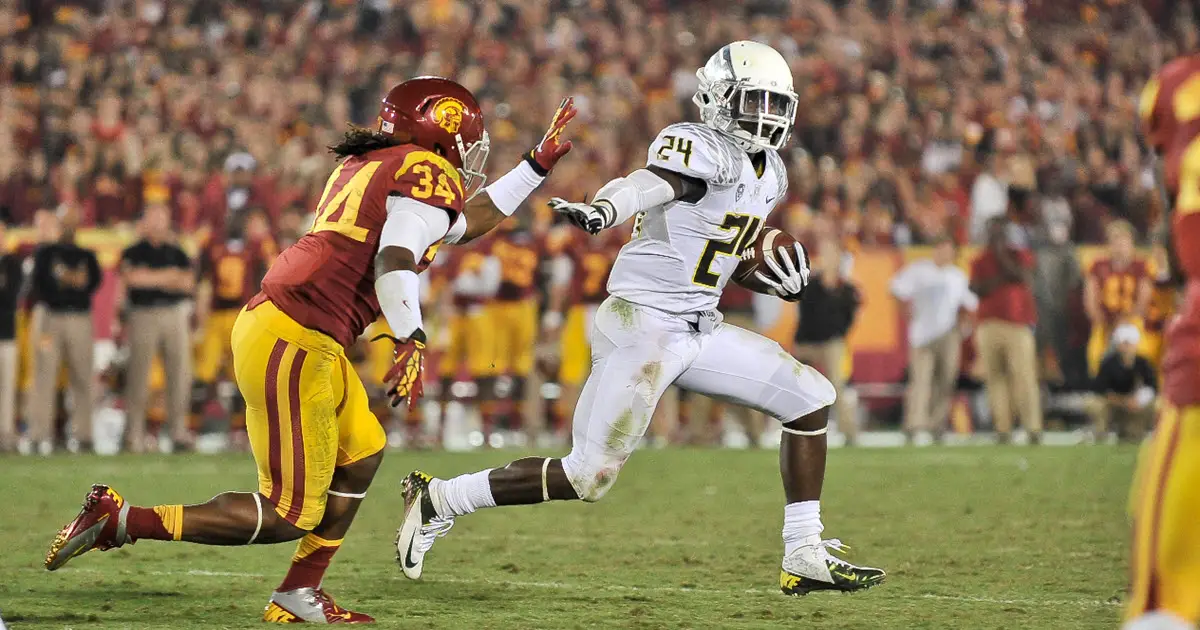Among the most pivotal points that propelled Oregon past USC the past decade was the 2012 matchup in Los Angeles. The Trojans went into the season ranked No. 1 under current Ole Miss head coach Lane Kiffin. The Ducks stormed L.A. in their all-white “Stormtrooper” kits and put a “65” on the L.A. Coliseum scoreboard. In the seven seasons since, USC has managed only one win over Oregon.
Offensive game plans typically open with a script of pre-determined plays to see how the defense reacts to various formations and schemes, and the game plan proceeds based on adjustments to the defense’s reactions to that opening script. In their 2012 win over USC, the Ducks offensive script was Oscar-worthy, as were its post-script adjustments. In this article we will analyze the script that flipped the balance of power in the Pac-12.
Attacking the Apex
In the opening series Oregon attacks the Apex player, the linebacker or strong safety that can align to play both the run or pass (circled player in video above). Against USC, many of these opening plays were designed to attack the Trojans’ All-American safety (No. 7) T.J. McDonald. USC knows they need McDonald to help stop Oregon’s strong run game, and so they initially align him in the box close to the line of scrimmage.
Oregon was prepared for this and attacks McDonald by throwing inside, outside, under, and over McDonald’s alignment. This forces McDonald to retreat into pass coverage and away from run support, with an additional element of wearing him out as the game progresses. The Ducks cap their first drive with a 16-yard TD pass to De’Anthony Thomas over the top of the defense.
Attacking the Middle and Outside
After exposing USC with the passing game, the Ducks adjust in their second offensive series to attack the middle of USC’s defense. In the video above, the apex player is aligned wider and the safeties are so deep they are often out of the picture. Oregon uses run plays, quick passes, and tunnel screens to attack the softened underbelly of the Trojan defense. Oregon’s second drive ends with a 21-yard TD off a Josh Huff tunnel screen.
Total Control
Oregon has now taken a stranglehold of the USC defense. The Trojans have given up two touchdown passes on the two previous drives and almost every linebacker and defensive end has either taken on a run blocker, been read by the QB on a run play, or been forced to play pass defense. Oregon has the defense stretched wide and deep, providing the Ducks a numbers advantage in the run game. The Ducks turn up the tempo and begin hammering the run.
Oregon’s warp-speed tempo is now wearing down and confusing the USC defense. Oregon’s lethal backfield of Marcus Mariota, Barner and De’Anthony Thomas begin gashing the Trojans for chunk yardage, and the series ends with a 27-yard TD scamper by Barner.

Kenjon Barner had a game for the ages…
Barner had very few carries on the first two scripted possessions, but Trojans’ reaction to those scripted plays created an opportunity to shift to a ground-and-pound offense. Barner took advantage of that opportunity to the tune of 38 carries for 321 yards and five touchdowns.
When the Ducks finally kickoff the season on November 7, it will be exciting to see new offensive coordinator Joe Moorhead’s opening scripts and in-game adjustments. The script for a national championship has become recruiting and game planning, but in-game opening scripts and adjustments will be key to accumulating wins in the Ducks’ abbreviated league schedule, a schedule which may very well culminate in a championship game against USC.
Perhaps Moorhead can write a storybook ending for Our Beloved Ducks?
Jeremy Mosier
Geneseo, Illinois
Top Photo by Kaly Harward

Phil Anderson, the FishDuck.com Volunteer editor for this article, is a trial lawyer in Bend Oregon.
Longtime Oregon Duck fan with family in Portland. Former Offensive coach at Glenwood High School in Illinois. Team qualified for the Sweet 16, 3 Elite 8 appearances, and one state championship game in class 6A. Currently an administrator at Geneseo High School in Illinois. Father to four kids ages 9, 7, 4, and 2 years old. Coached former athletes that have went on to play college football at numerous schools such as Clemson, Duke, and Army. NCAA athlete at Millikin University 2000-2004.

